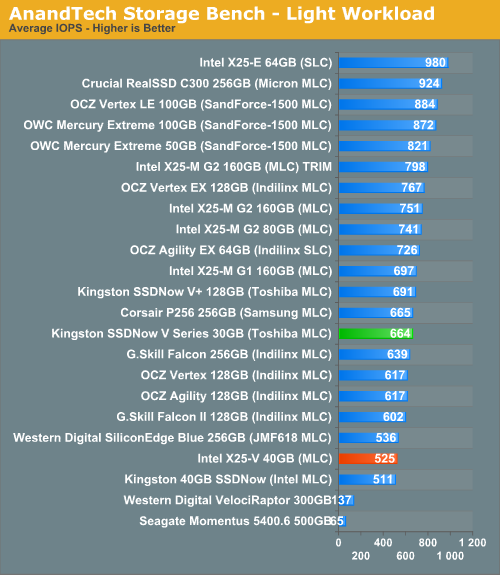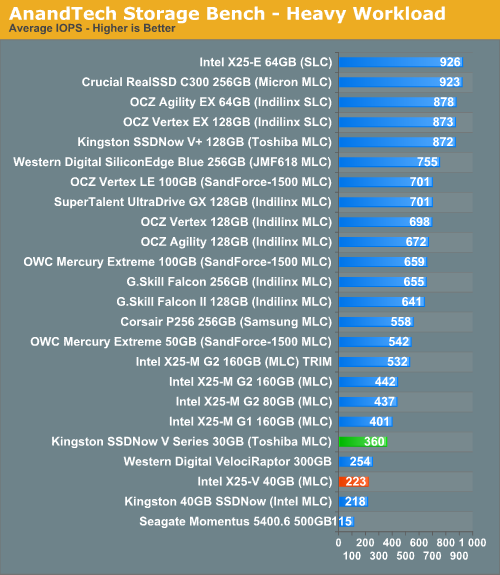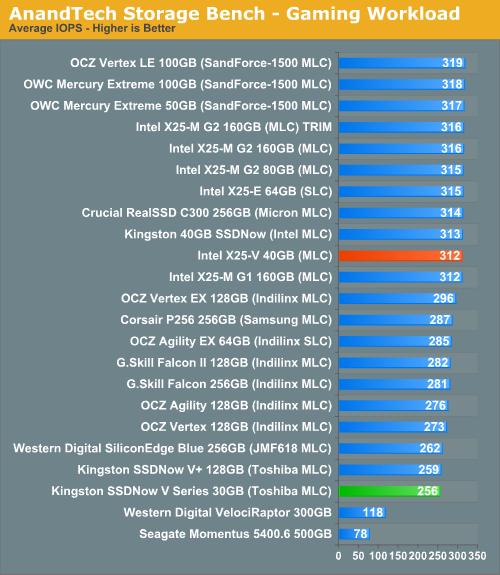Intel's X25-V & Kingston's 30GB SSDNow V Series: Battle of the $125 SSDs
by Anand Lal Shimpi on March 19, 2010 12:00 AM EST- Posted in
- Storage
AnandTech Storage Bench
Note that our 6Gbps controller driver isn't supported by our custom storage bench here, so the C300 results are only offered in 3Gbps mode.
The first in our benchmark suite is a light usage case. The Windows 7 system is loaded with Firefox, Office 2007 and Adobe Reader among other applications. With Firefox we browse web pages like Facebook, AnandTech, Digg and other sites. Outlook is also running and we use it to check emails, create and send a message with a PDF attachment. Adobe Reader is used to view some PDFs. Excel 2007 is used to create a spreadsheet, graphs and save the document. The same goes for Word 2007. We open and step through a presentation in PowerPoint 2007 received as an email attachment before saving it to the desktop. Finally we watch a bit of a Firefly episode in Windows Media Player 11.
There’s some level of multitasking going on here but it’s not unreasonable by any means. Generally the application tasks proceed linearly, with the exception of things like web browsing which may happen in between one of the other tasks.
The recording is played back on all of our drives here today. Remember that we’re isolating disk performance, all we’re doing is playing back every single disk access that happened in that ~5 minute period of usage. The light workload is composed of 37,501 reads and 20,268 writes. Over 30% of the IOs are 4KB, 11% are 16KB, 22% are 32KB and approximately 13% are 64KB in size. Less than 30% of the operations are absolutely sequential in nature. Average queue depth is 6.09 IOs.
The performance results are reported in average I/O Operations per Second (IOPS):

Intel's X25-V performs virtually identically to the older Kingston 40GB Boot Drive. The new 30GB drive does have the advantage though, performing much more like an Indilinx drive than a scaled down X25-M thanks to its higher sequential write speed.
If there’s a light usage case there’s bound to be a heavy one. In this test we have Microsoft Security Essentials running in the background with real time virus scanning enabled. We also perform a quick scan in the middle of the test. Firefox, Outlook, Excel, Word and Powerpoint are all used the same as they were in the light test. We add Photoshop CS4 to the mix, opening a bunch of 12MP images, editing them, then saving them as highly compressed JPGs for web publishing. Windows 7’s picture viewer is used to view a bunch of pictures on the hard drive. We use 7-zip to create and extract .7z archives. Downloading is also prominently featured in our heavy test; we download large files from the Internet during portions of the benchmark, as well as use uTorrent to grab a couple of torrents. Some of the applications in use are installed during the benchmark, Windows updates are also installed. Towards the end of the test we launch World of Warcraft, play for a few minutes, then delete the folder. This test also takes into account all of the disk accesses that happen while the OS is booting.
The benchmark is 22 minutes long and it consists of 128,895 read operations and 72,411 write operations. Roughly 44% of all IOs were sequential. Approximately 30% of all accesses were 4KB in size, 12% were 16KB in size, 14% were 32KB and 20% were 64KB. Average queue depth was 3.59.

Crank up the sequential writes and Kingston's lead grows. The 30GB V series drive almost performs like an X25-M G1 in this case. The X25-V on the other hand performs more like a low latency VelociRaptor. Still better than a hard drive, but don't expect to copy files any faster.
The gaming workload is made up of 75,206 read operations and only 4,592 write operations. Only 20% of the accesses are 4KB in size, nearly 40% are 64KB and 20% are 32KB. A whopping 69% of the IOs are sequential, meaning this is predominantly a sequential read benchmark. The average queue depth is 7.76 IOs.

With both Intel and Kingston equal in sequential read performance, the differentiating factor here is strictly random read performance where the X25-V has the edge.










78 Comments
View All Comments
Anand Lal Shimpi - Friday, March 19, 2010 - link
The SSD Toolbox won't work on RAID volumes unfortunately.Take care,
Anand
buzznut - Monday, March 22, 2010 - link
Thanks Anand for clarifying the raid and SSD toolbox issues. I can see now that adding a second 40 GB drive will not be a good idea and I should save for a larger capacity.I am very interested in knowing when Intel gets trim working for raid! Good to know I can count on Anandtech for the latest SSD news. Thanks again, Scott
pkoi - Friday, March 19, 2010 - link
The difference between 30gb and 40gb is HUGE,,, I would need 50 to swap my bloated win7inighthawki - Friday, March 19, 2010 - link
I have a 30GB partition for Win7 and still have 8GB left, and that's after some pretty careless space management. I don't understand how yours can be so bloated. You're not counting things like program files, are you? You're aware that the users and program files folders aren't part of your windows installation, right?gerstena - Friday, March 19, 2010 - link
"I have a 30GB partition for Win7 and still have 8GB left, and that's after some pretty careless space management."Unfortunately things like volume shadow services and the source files of windows updates quickly eat up the space. A lot of users won't know about these things.
The only thing I have found drives under 60 GB useful for are speeding up database operations and development.
hoohoo - Tuesday, March 23, 2010 - link
I have 8 GB for OpenSuSE 11.2 and still have 3 GB free.I dunno about Windows bloat - yours or the other guy's!
davepermen - Friday, March 19, 2010 - link
I need one. it would be enough for 3 windows 7.no clue how bloated yours is :)
loimlo - Tuesday, March 30, 2010 - link
Dear AnandYour nice review of Kingston indeed encouraged me to purchase Kingston 64GB SSD for my win7 system, but your TRIM comment just kept my purchase impulse at bay. Would you mind clarifying the TRIM situation in the future? If nothing wrong with TRIM implementation on Kingston SSD, I'll buy bigger brother, 64GB SSD, for my system immediately!
Thanks